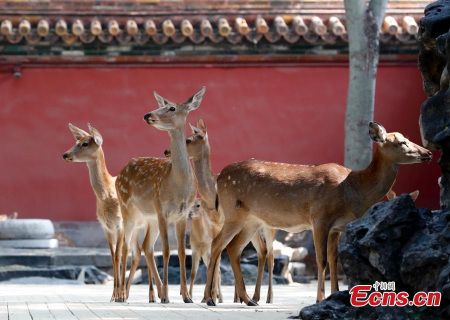
Nine sika deer- two males, five females and two cubs - accompanied by veterinarian arrived in the Forbidden City in Beijing on Thursday. The sika deer from Chengde Mountain resort will be on public display from Sept 26, 2017 to February, 2018. To better promote its cultural relics and historic architecture, the Palace Museum has introduced animals and plants related to the royal life.(Photo: China News Service/Du Yang)
As the Internet and social media continue to change the ways people communicate with each other, traditional institutions such as museums and art galleries have been trying to find ways to present culture and their collections in new and intriguing ways that better suit the tastes of today's always connected generation.
This has been especially true this year for museums in China.
Several new TV shows and films about the collections in many famous museums, such as Masters in Forbidden City and The National Treasures, have been well-received by audiences. The star power of film stars and pop idols is also being leveraged by these shows to help get younger viewers more interested in the history and culture of China.
Meanwhile, inside the museums themselves, new technology is being used to make collections more accessible to the public, and new methods of presenting collections are being adopted so visitors can more easily understand the historical connections that these relics have with today's society.
New directions
"The Palace Museum has launched some new exhibitions designed to connect the inside of exhibition halls with the outside grounds, and material objects with intangible culture," Shan Jixiang, the director of the Palace Museum, told the Global Times.
As one of the top 10 museums in the world, the Palace Museum in Beijing has become a pioneer when it comes to changing the way things are done in China. For instance, instead of grouping its collection based on the type of material, such as displays featuring all paintings, jades or ceramics, they have begun experimenting with exhibits featuring a multitude of different items all grouped around a particular theme. These exhibits, such as its Peony Flower Exhibition and Auspicious Deer Artifacts which displayed real peony flowers and live deer at their respective exhibits, were big hits among visitors since it allowed them to compare works of art to the real thing.
Touching on new subjects, such as exhibits showing the connections between China and the rest of the world through the ages, has also been part of these new experiments.
"We haven't covered this kind of topic before, Zheng Hong, the curator of the Palace Museum's The Forbidden City and the Maritime Silk Road exhibition, told the Global Times. "The exhibition shows how China exchanged its culture and material goods with other foreign countries, and how it, in return, was influenced by other cultures. I've seen visitors from Portugal, Hong Kong and many other places come to the exhibit. They were all curious about the cultural exchanges taking place in ancient times."
Making use of the latest modern technology is also part of the Palace Museum's push to keep its collection alive in the minds of the public.
"We are trying to make the relics come alive so they can impress people," Shan explained.
"Our collection is being digitized and stored in a database. To better serve netizens, we continually update our website so all visitors can browse the collection online."
The museum plans to continue taking steps to move into the future during 2018.
Currently, the museum is working on developing experiences for virtual reality.
According to Shang Xiaohong, the expert in charge of the VR project, they plan to set up a VR hall where people will be able to "travel" to the past and interact with history in a more visceral way.
Highlights of 2017
Numerous national treasures were put on display this year, attracting millions of visitors into museums across China.
Exhibitions including A Thousand Miles of Rivers and Mountains and Paintings and Calligraphic Works of Zhao Mengfu at the Palace Museum and the Tibet in the Heaven - Joint Exhibition of Top Tibetan Thangka Works at the National Museum of China were big hits among visitors, who in some cases formed long lines to wait their turn to appreciate these artworks.
"I traveled a long way from Germany to China just for this exhibition," Thilo Westermann, an artist from Berlin who waited for half an hour to get into the Calligraphic Works of Zhao Mengfu, told the Global Times.
"I learned a lot from this visit."
Some major archeological excavations have uncovered numerous valuable relics in recent years. This year, the Capital Museum in Beijing, as well as several other provincial museums, played important roles in bringing the fruits of these archeologists' efforts closer to people's lives.
In April, the Shanghai Museum hosted the Archeological Discoveries from the Historical Port of Qinglong Town in Shanghai exhibition. Showing off the latest archeological findings, the exhibition helped introduce some of the city's unknown history to visitors.
As this year marked several important anniversaries, notably the 80th anniversary of the Nanjing Massacre and the 90th anniversary of the founding of the People's Liberation Army (PLA), exhibits memorializing these events proved useful in educating today's youth about China's history.
Looking to remember China's recent history, the National Museum of China hosted an exhibition outlining the events that led up to the formation of the PLA during the Nanchang Uprising in 1927 and its following history.
While history has many moments worth celebrating, there are also darker moments.
These tragic times can be difficult to revisit, but it is important to do so to ensure that history does not repeat itself. To this end, the National Art Museum of China held an exhibition that delved into the Nanjing Massacre, a more than month-long slaughter in late 1937 during which the Japanese army brutally murdered about 300,000 civilians and Chinese soldiers.


















































